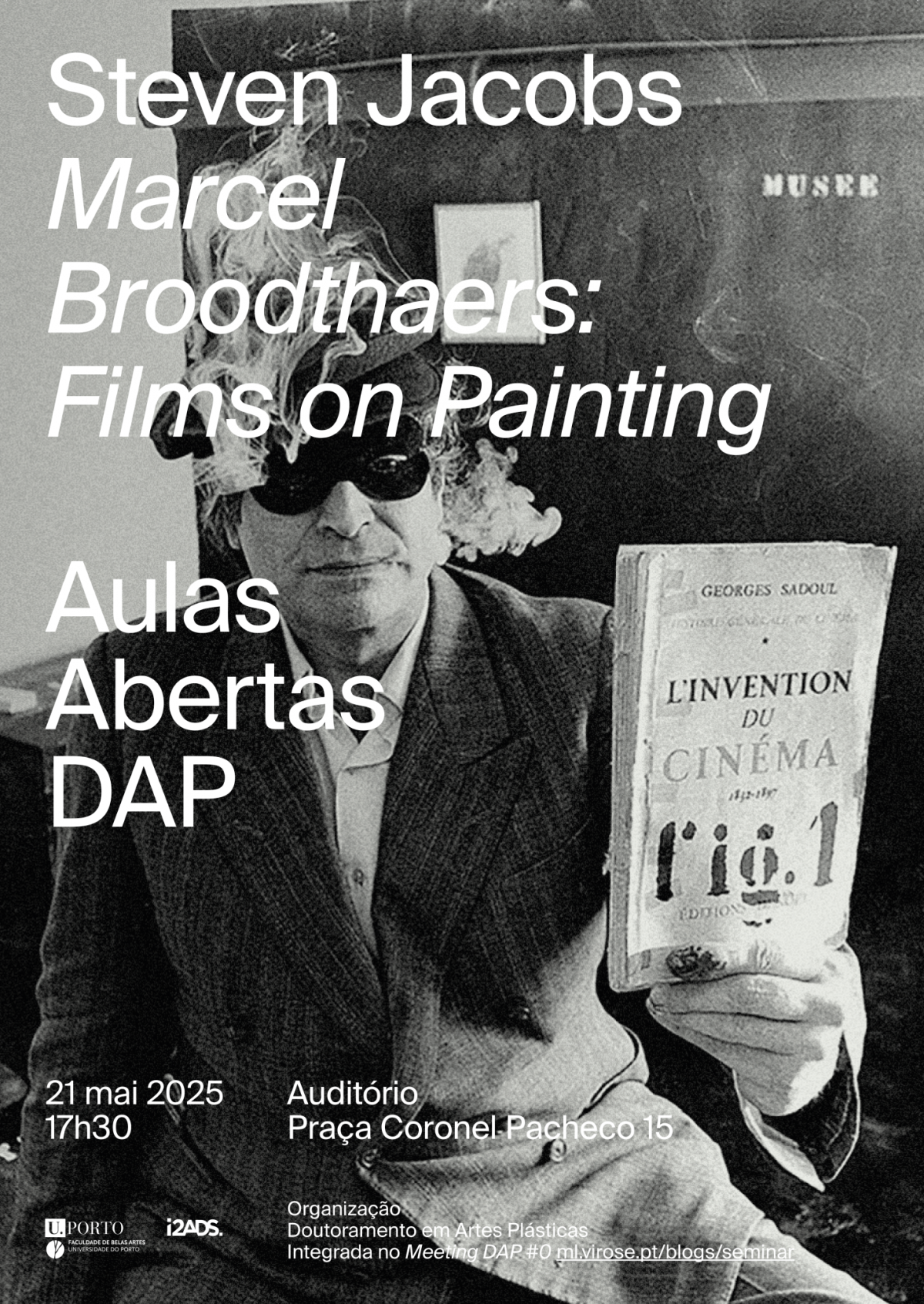Aula Aberta com Steven Jacobs
Marcel Broodthaers: Films on Painting
Quarta-feira, 21 de Maio de 2025, 17h
Auditório Piso 0 do Edifício de Coronel Pacheco
Belgian artist Marcel Broodthaers (1924-1976) is rarely seen as a filmmaker although he was a prolific one with a filmography containing at least 50 titles. Furthermore, his entire (non-filmic) oeuvre and his writings include many references to cinema, its (pre-)history, technology, and paraphernalia. Often presented as the ultimate artist of the “post-medium condition,” constantly merging artistic media, technologies, and methods of display, Broodthaers strikingly made several films dealing with still images such as inscriptions, newspaper clippings, postcards, maps, drawings, prints, and paintings.
Focusing on La Clef de l’horloge (1957-58) and A Voyage on the North Sea (1973-74), this lecture deals with Broodthaers’s cinematic exploration of paintings, particularly a Kurt Schwitters relief in the first film and an anonymous seascape created around 1900 in the latter. Both films employ completely different strategies in their encounter with artworks. While La Clef de l’horloge, with its restless light effects, hectic camera movements, and rhythmic montage embraces the dynamic potential of cinema, A Voyage on the North Sea is marked by a static camera and a slow editing rhythm, rather emphasizing than neglecting or transforming the static qualities of the source image.
In particular, this paper will discuss Broodthaers’s cinematic investigations of artworks against the background of the somewhat understudied mid-century development of highly experimental and lyrical art documentaries, which was particularly important in Belgium. From the late 1930s to the early 1960s, Belgian filmmakers such as André Cauvin, Henri Storck, Paul Haesaerts, and Luc de Heusch among others self-consciously presented their films on art as art films, investigating the tensions between movement and stasis, the two- and three-dimensional, and the real and the artificial. These ambitions resonate in Broodthaers’s films dealing with paintings, which are marked by a preoccupation with transmedial encounters, duration, the tensions between stasis and movement, the transformative and ekphrastic potentialities of cinema, and the logics of mechanical reproduction.

Belgian artist Marcel Broodthaers (1924-1976) is rarely seen as a filmmaker although he was a prolific one with a filmography containing at least 50 titles. Furthermore, his entire (non-filmic) oeuvre and his writings include many references to cinema, its (pre-)history, technology, and paraphernalia. Often presented as the ultimate artist of the “post-medium condition,” constantly merging artistic media, technologies, and methods of display, Broodthaers strikingly made several films dealing with still images such as inscriptions, newspaper clippings, postcards, maps, drawings, prints, and paintings.
Focusing on La Clef de l’horloge (1957-58) and A Voyage on the North Sea (1973-74), this lecture deals with Broodthaers’s cinematic exploration of paintings, particularly a Kurt Schwitters relief in the first film and an anonymous seascape created around 1900 in the latter. Both films employ completely different strategies in their encounter with artworks. While La Clef de l’horloge, with its restless light effects, hectic camera movements, and rhythmic montage embraces the dynamic potential of cinema, A Voyage on the North Sea is marked by a static camera and a slow editing rhythm, rather emphasizing than neglecting or transforming the static qualities of the source image.
In particular, this paper will discuss Broodthaers’s cinematic investigations of artworks against the background of the somewhat understudied mid-century development of highly experimental and lyrical art documentaries, which was particularly important in Belgium. From the late 1930s to the early 1960s, Belgian filmmakers such as André Cauvin, Henri Storck, Paul Haesaerts, and Luc de Heusch among others self-consciously presented their films on art as art films, investigating the tensions between movement and stasis, the two- and three-dimensional, and the real and the artificial. These ambitions resonate in Broodthaers’s films dealing with paintings, which are marked by a preoccupation with transmedial encounters, duration, the tensions between stasis and movement, the transformative and ekphrastic potentialities of cinema, and the logics of mechanical reproduction.

